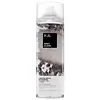What's inside
What's inside
 Key Ingredients
Key Ingredients

No key ingredients
 Benefits
Benefits

 Concerns
Concerns

 Ingredients Side-by-side
Ingredients Side-by-side

Hydrofluorocarbon 152a
Isobutane
Alcohol Denat.
AntimicrobialOryza Sativa Starch
AbsorbentPropane
Hydroxypropylcellulose
EmulsifyingMicrocrystalline Cellulose
AbsorbentDipropylene Glycol
HumectantCetrimonium Chloride
AntimicrobialCaprylyl Glycol
EmollientDisteardimonium Hectorite
StabilisingPentylene Glycol
Skin ConditioningPropanediol
SolventCitronellyl Methylcrotonate
MaskingCellulose
AbsorbentWater
Skin ConditioningFurcellaria Lumbricalis Extract
Skin ConditioningZeolite
AbsorbentEthylcellulose
C12-15 Alketh-7
EmulsifyingParfum
MaskingEthylhexylglycerin
Skin ConditioningLimonene
PerfumingCitronellol
PerfumingHexyl Cinnamal
PerfumingBenzyl Salicylate
PerfumingCitral
PerfumingMethyldihydrojasmonate
MaskingEthyl Linalool
MaskingPentadecalactone
MaskingCitrus Paradisi Peel Oil
MaskingCitrus Aurantium Dulcis Peel Oil
MaskingAmyl Salicylate
PerfumingHydrofluorocarbon 152a, Isobutane, Alcohol Denat., Oryza Sativa Starch, Propane, Hydroxypropylcellulose, Microcrystalline Cellulose, Dipropylene Glycol, Cetrimonium Chloride, Caprylyl Glycol, Disteardimonium Hectorite, Pentylene Glycol, Propanediol, Citronellyl Methylcrotonate, Cellulose, Water, Furcellaria Lumbricalis Extract, Zeolite, Ethylcellulose, C12-15 Alketh-7, Parfum, Ethylhexylglycerin, Limonene, Citronellol, Hexyl Cinnamal, Benzyl Salicylate, Citral, Methyldihydrojasmonate, Ethyl Linalool, Pentadecalactone, Citrus Paradisi Peel Oil, Citrus Aurantium Dulcis Peel Oil, Amyl Salicylate
Butane
Propane
Sd Alcohol 40-B
AstringentAluminum Starch Octenylsuccinate
AbsorbentOryza Sativa Starch
AbsorbentZeolite
AbsorbentAcrylates Copolymer
Hydrated Silica
AbrasiveCharcoal Powder
AbrasiveSodium Bicarbonate
AbrasiveMagnesium Carbonate
AbsorbentDiisopropyl Adipate
EmollientCellulose
AbsorbentHydroxyethylcellulose
Emulsion StabilisingCamellia Sinensis Leaf Extract
AntimicrobialDisteardimonium Hectorite
StabilisingButylene Glycol
HumectantPolyquaternium-59
UV AbsorberCetrimonium Chloride
AntimicrobialSodium Acetate
BufferingWater
Skin ConditioningPhenoxyethanol
PreservativeParfum
MaskingButane, Propane, Sd Alcohol 40-B, Aluminum Starch Octenylsuccinate, Oryza Sativa Starch, Zeolite, Acrylates Copolymer, Hydrated Silica, Charcoal Powder, Sodium Bicarbonate, Magnesium Carbonate, Diisopropyl Adipate, Cellulose, Hydroxyethylcellulose, Camellia Sinensis Leaf Extract, Disteardimonium Hectorite, Butylene Glycol, Polyquaternium-59, Cetrimonium Chloride, Sodium Acetate, Water, Phenoxyethanol, Parfum
 Reviews
Reviews

Ingredients Explained
These ingredients are found in both products.
Ingredients higher up in an ingredient list are typically present in a larger amount.
Cellulose is the main component of plant cell walls. It is used as an emulsifier, absorbent, and texture enhancer.
This ingredient has many functions:
Fun fact: Cellulose is the most abundant form of organic polymer on Earth.
Learn more about CelluloseThis ingredient is a preservative, antimicrobial, and emulsifier. It is often used in cosmetics for its ability to cleanse, condition, and reduce static.
Cetrimonium chloride is a quaternary ammonium salt, meaning it has a water-soluble structure.
Disteardimonium Hectorite comes from the clay mineral named hectorite. It is used to add thickness to a product.
It can also help stabilize a product by helping to disperse other ingredients.
Hectorite is a rare, white clay mineral.
Learn more about Disteardimonium HectoriteOryza Sativa Starch is an absorbent and used to mattify the skin. It is a natural carbohydrate and the main component of rice. A more common name for this ingredient is 'rice starch'.
Rice starch is created by steeping broken grains in a caustic soda.
Rice extract has many skin benefits. Read more about rice extract here.
Learn more about Oryza Sativa StarchParfum is a catch-all term for an ingredient or more that is used to give a scent to products.
Also called "fragrance", this ingredient can be a blend of hundreds of chemicals or plant oils. This means every product with "fragrance" or "parfum" in the ingredients list is a different mixture.
For instance, Habanolide is a proprietary trade name for a specific aroma chemical. When used as a fragrance ingredient in cosmetics, most aroma chemicals fall under the broad labeling category of “FRAGRANCE” or “PARFUM” according to EU and US regulations.
The term 'parfum' or 'fragrance' is not regulated in many countries. In many cases, it is up to the brand to define this term.
For instance, many brands choose to label themselves as "fragrance-free" because they are not using synthetic fragrances. However, their products may still contain ingredients such as essential oils that are considered a fragrance by INCI standards.
One example is Calendula flower extract. Calendula is an essential oil that still imparts a scent or 'fragrance'.
Depending on the blend, the ingredients in the mixture can cause allergies and sensitivities on the skin. Some ingredients that are known EU allergens include linalool and citronellol.
Parfum can also be used to mask or cover an unpleasant scent.
The bottom line is: not all fragrances/parfum/ingredients are created equally. If you are worried about fragrances, we recommend taking a closer look at an ingredient. And of course, we always recommend speaking with a professional.
Learn more about ParfumPropane is a gas derived from petroleum and natural gas. It is used as a propellant.
This ingredient is most commonly used in shaving cream, hair products, and makeup.
Water. It's the most common cosmetic ingredient of all. You'll usually see it at the top of ingredient lists, meaning that it makes up the largest part of the product.
So why is it so popular? Water most often acts as a solvent - this means that it helps dissolve other ingredients into the formulation.
You'll also recognize water as that liquid we all need to stay alive. If you see this, drink a glass of water. Stay hydrated!
Learn more about WaterWe don't have a description for Zeolite yet.